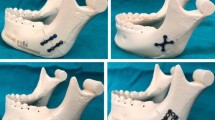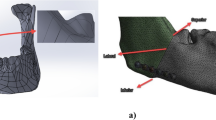Abstract
Mandibular fractures at the condylar region are normally treated with miniplates made of high stiffness and strength metallic materials. Rigid fixation is important to maintain the position of the two bone segments, thus improving the chances of bone union. Failure to achieve adequate stability will result in malunion or nonunion. In this study, two different orientations of miniplates were used to analyse the primary stability of the fractured site using finite element method. Three dimensional model of a mandible was reconstructed from CT dataset, and a low subcondylar fracture was simulated on the right side of the mandible. A straight 4-hole miniplate was modeled and placed onto the condylar neck axis and fixed with 2 screws, 2mm in diameter and 7mm long on either side of the fracture line. Two different orientations of the miniplates were used for comparison of primary stability and load transfer to the bone — along the condylar neck and below the mandibular notch. Non-linear contact analysis was used and the bone segments were allowed to slide against each other. Results showed that interface micromotion and stress distribution was larger for the miniplate positioned along the condylar neck compared to the one placed below the mandibular notch. For maximum stability, it is advisable to fix the straight miniplate across the fractured segment below the condylar notch.
Access this chapter
Tax calculation will be finalised at checkout
Purchases are for personal use only
Preview
Unable to display preview. Download preview PDF.
Similar content being viewed by others
References
Cox T, Kohn M W and Impelluso T (2003) Computerized analysis of resorbable polymer plates and screws for the rigid fixation of mandibular angle fractures. J Oral and Maxillofacial Surgery, Vol 61, pp 481–487
Choi B H, Min Y S, Yi C K et al (2000) A comparison of the stability of miniplate with bicortical screw fixation after sagittal split setback”, Oral Surg Oral Med Oral Pathol Oral Radio Endod, Vol 90, pp 416–419
Chuong C J, Borotikar B, Schwartz D C et al (2005) Mandible after bilateral sagittal split ramus osteotomy: comparing 2 different fixation techniques. Journal of Oral and Maxillofacial Surgery, Vol 63, pp 68–76
Crofts C E, Trowbridge A, Aung T M (1990) A comparative in vitro study of fixation of mandibular fractures with paraskeletal clamps or screw plates. J Oral Maxillofac Surg, Vol 48, pp 461–467
Ellis E and Dean J (1993) Rigid fixation of mandibular condyle fractures. Oral Surg Oral Med Oral Pathol, Vol 76, No 6
Ellis E and Goallo J (1986) Relapse following mandibular advancement with dental plus skeletal maxillomandibular fixation. Oral Maxillofac Surg, Vol 44, pp 509–515
Erkmen E, Simsek B E, Yucel E et al (2005) Comparison of different fixation methods following sagittal split ramus osteotomies using three-dimensional finite elements analysis Part 1: advancement surgeryposterior loading. International Journal of Oral and Maxillofacial Surgery, Vol 34, pp 551–558
Kimura A, Nagasao T, Kaneko T et al (2006) Adaquate fixation of plates for stability during mandibular reconstruction J Cranio-Maxillofacial Surgery, Vol 34, pp 193–200
Irish J C, Gullane P J, Gilbert R W et al (1995) Primary mandibular reconstruction with the titanium hollow screw reconstruction plate: evaluation of 51 cases. Plast Reconstr Surg, Vol 96, pp 93–99
Abdul Kadir M R et al (2007) Finite element modelling of primary hip stem stability: The effect of interference fit, Journal of Biomechanics, In Press, Corrected Proof, Available online 26 November 2007
Foley W L and Beckman T W (1992) In vitro comparison of screw versus plate fixation in the sagittal split osteotomy. International Journal Adult Orthodont Ortognath Surg, Vol 7, pp 147–151
Gerlach V K L and Pape H D (1980) Prinzip und indikation der miniplattenosteosynthese. Dtsch zahnnarztl Z, Vol 35, pp 346
Haug R H (1993) The effects of screw number and length on two methods of tension band plating. J Oral Maxillofac Surg, Vol 51, pp 159–162
Hammer B, Schier J, And Prein J (1997) Osteosynthesis of condylar neck fractures: A review of 30 patients. Br J Oral Maxillofac Surg, Vol 35, pp 288
Gallas T M, and Fernandez J R (2004) A three-dimensional computer model of the human mandible in two simulated standard trauma situations. J Cranio Maxillo Fac Surg, Vol 32, pp 303–307
Maurer P, Holweg S, Knoll W D et al (2002) Study by finite element method of the mechanical stress of selected biodegradable osteosynthesis screws in sagittal ramus osteotomy. Br J Oral Maxillofac Surg, Vol 40, pp 76–83
Nagasao T, Kobayashi M, Tsuchiya Y et al (2002) Finite element analysis of the stresses around endosseous implants in various reconstructed mandibular models. J Cranio-Maxillofac Surg, Vol 30, pp 170–177
Nagasao T, Kobayashi M, Tsuchiya Y et al (2003) Finite element analysis of the stresses around fixtures in various reconstructed mandibular models. Part II (effect of horizontal load). J Cranio-Maxillofac Surg, Vol 31, pp 168–175
Maurer P, Holweg S and Schubert J (1999) Finite-element-analysis of different screw diameters in the sagittal split osteotomy of the mandible. J Cranio-Maxillofac Surg, Vol 27, pp 365–372
Shetty V, Freymiller E, McBrearty D et al (1996) Functional stability of sagittal split ramus osteotomies: effects of positional screw size and placement configuration. J Oral Maxillofac Surg 1996, Vol 54, pp 601–609
Pilliar R M (1991) Quantitative evaluation of the effect of movement at a porous coated implant-bone interface, The Bone-Biomaterial Interface, 1st edn, J. E. Davies, ed., University of Toronto Press, pp 380–387
Author information
Authors and Affiliations
Corresponding author
Editor information
Editors and Affiliations
Rights and permissions
Copyright information
© 2008 Springer-Verlag Berlin Heidelberg
About this paper
Cite this paper
Abdul Kadir, M.R., Haron, H., Kamsah, N., Nordin, N. (2008). Miniplates Orientation for Fracture Fixation of the Mandibular Condyle. In: Abu Osman, N.A., Ibrahim, F., Wan Abas, W.A.B., Abdul Rahman, H.S., Ting, HN. (eds) 4th Kuala Lumpur International Conference on Biomedical Engineering 2008. IFMBE Proceedings, vol 21. Springer, Berlin, Heidelberg. https://doi.org/10.1007/978-3-540-69139-6_111
Download citation
DOI: https://doi.org/10.1007/978-3-540-69139-6_111
Publisher Name: Springer, Berlin, Heidelberg
Print ISBN: 978-3-540-69138-9
Online ISBN: 978-3-540-69139-6
eBook Packages: EngineeringEngineering (R0)




